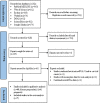Disease progression role as well as the diagnostic and prognostic value of microRNA-21 in patients with cervical cancer: A systematic review and meta-analysis
- PMID: 35895593
- PMCID: PMC9328569
- DOI: 10.1371/journal.pone.0268480
Disease progression role as well as the diagnostic and prognostic value of microRNA-21 in patients with cervical cancer: A systematic review and meta-analysis
Abstract
Introduction: Cervical cancer is the fourth commonest and the fourth leading cause of cancer death in females globally. The upregulated expression of microRNA-21 in cervical cancer has been investigated in numerous studies, yet given the inconsistency on some of the findings, a systematic review and meta-analysis is needed. Therefore, the aim of this systematic review and meta-analysis is to investigate the role in disease progression as well as the diagnostic and prognostic value of microRNA-21 in patients with cervical cancer.
Methods: Literature search was carried out through visiting several electronic databases including PubMed/MEDLINE/ PubMed Central, Web of Science, Embase, WorldCat, DOAJ, ScienceDirect, and Google Scholar. After extraction, data analysis was carried out using Rev-Man 5.3, STATA 15.0 and Meta-disk 1.4. I2 and meta-bias statistics assessed heterogeneity and publication bias of the included studies, respectively. The area under summary receiver operating characteristic curve and other diagnostic indexes were used to estimate diagnostic accuracy.
Result: A total of 53 studies were included for this systematic review and meta-analysis. This study summarized that microRNA-21 targets the expression of numerous genes that regulate their subsequent downstream signaling pathways which promote cervical carcinogenesis. The targets addressed in this study included TNF-α, CCL20, PTEN RasA1, TIMP3, PDCD-4, TPM-1, FASL, BTG-2, GAS-5, and VHL. In addition, the meta-analysis of reports from 6 eligible studies has demonstrated that the overall area under the curve (AUC) of summary receiver operating characteristic (SROC) of microRNA-21 as a diagnostic accuracy index for cervical cancer was 0.80 (95% CI: 0.75, 0.86). In addition, evidence from studies revealed that upregulated microRNA-21 led to worsening progression and poor prognosis in cervical cancer patients.
Conclusion: microRNA-21 is an oncogenic microRNA molecule playing a key role in the development and progression of cervical malignancy. It has good diagnostic accuracy in the diagnosis of cervical cancer. In addition, the upregulation of microRNA-21 could predict a worse outcome in terms of prognosis in cervical cancer patients.
Conflict of interest statement
The authors have declared that no competing interests exist.
Figures







References
-
- Jameson JL: Harrison’s principles of internal medicine, 19th edn: McGraw-Hill Education; 2018.
-
- Sung H, Ferlay J, Siegel RL, Laversanne M, Soerjomataram I, Jemal A, et al.: Global cancer statistics 2020: GLOBOCAN estimates of incidence and mortality worldwide for 36 cancers in 185 countries. 2021, 71(3):209–249. - PubMed
Publication types
MeSH terms
Substances
LinkOut - more resources
Full Text Sources
Medical
Research Materials
Miscellaneous

